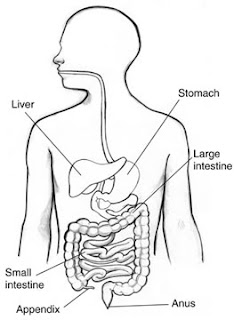The digestive system is composed of the digestive tract and organs that aid in digestion of food. The digestive tract includes the mouth, pharynx, esophagus, stomach, small intestine, large intestine, and the anus.
Other organs or structures that help in digesting food are the teeth, salivary glands, the liver, and the pancreas.
The following are brief descriptions of the common digestive diseases.
Appendicitis
Appendicitis is the inflammation of the appendix—a small organ attached to the first part of the large intestine. It can be caused by blockage to the lumen of the appendix.
 The bacteria in the appendix can multiply and cause inflammation of the appendix. Symptoms of disease include pain in the lower right part of the abdomen, low-grade fever, nausea and vomiting.
The bacteria in the appendix can multiply and cause inflammation of the appendix. Symptoms of disease include pain in the lower right part of the abdomen, low-grade fever, nausea and vomiting.
Colon and Rectal Cancer
Cancer of the colon and rectum is sometimes called colorectal cancer. A type of cancer, colorectal cancer is one of the leading causes of cancer-related deaths worldwide, according to recent data provided by the World Health Organization. The condition occurs when cells in the colon or rectum abnormally divide forming a mass called tumor. The cancer cells can travel through the blood or lymph causing cancer in other organs of the body.
Possible signs of colon or rectal cancer include change in bowel habits and blood in the stool.
Colorectal cancer treatment is more effective if found early where cancer has not spread to other parts of the body. Treatment options for colorectal cancer include surgery, chemotherapy, and radiation therapy or a combination of these treatments.
[Top of Page]
Diarrhea
Diarrhea is a common problem, which is described as having loose, watery stools. People with diarrhea, according to the National Digestive Diseases Information Clearinghouse (NDDIC), often have frequent bowel movements and may pass more than a quart of watery stool a day. Having diarrhea can cause a person to be dehydrated, which can be life-threatening.
Common causes of diarrhea include infection with bacteria, viruses, or parasites; some foods; or health problems affecting the digestive system.
The main treatment of diarrhea involves replacing lost fluids.
Foodborne Illness or Food Poisoning
Foodborne illness can be caused by foods and beverages that have been contaminated by bacteria, viruses, or parasites. Symptoms of foodborne illness include upset stomach, diarrhea, abdominal cramping, and vomiting.
Gas (Flatulence)
Everyone can have gas, may it be in the form of burping or passing gas. More often, gas is odorless. The odor in passed gas, however, can be caused by sulfur that is normally produced by bacteria in the colon. Limiting foods known to cause gas may help.
[Top of Page]
Gastritis
Gastritis is the inflammation of the lining of the stomach. It is not a single disease but actually several conditions that have some inflammation of the stomach lining. Too much alcohol drinking, long-term use of certain pain relievers and certain bacterial infection can cause gastritis. Other health problems or conditions can cause gastritis as well.
Gastritis symptoms include pain or abdominal upset, bloating, and burning in the upper abdomen.
Gastroesophageal reflux (GER)
Gastroesophageal reflux occurs when the muscle called lower esophageal sphincter (LES) fails to close allowing stomach acid to flow back into the esophagus. The LES is a smooth muscle that acts as a valve between the esophagus and the stomach. The flowing back of stomach contents including acid is called a reflux, which can cause heartburn—a burning sensation on the chest.
Gastroesophageal reflux disease (GERD)
Gastroesophageal reflux disease is the more serious form of gastroesophageal reflux (GER). A reflux that occurs more often may mean that a person has GERD. Like GER, heartburn is a common symptom of GERD. However, GERD that persists for a long time can lead to more serious problems in the digestive tract.
[Top of Page]
Hemorrhoids
Hemorrhoids are swollen, inflamed veins around the anus or lower rectum. It is common in both men and women. In fact, according to the National Digestive Diseases Information Clearinghouse, about half of the population will experience hemorrhoids by age 50. The most common symptom of hemorrhoids is having blood in the stool. Pain may also be felt around the anus.
Most cases of hemorrhoids are temporary and usually goes away without special medical treatment.
Heartburn
Heartburn is the burning sensation felt on the chest when acid in the stomach flows back in the esophagus—the tube connecting the pharynx to the stomach. Heartburn is more of a symptom of a health problem rather than a disease itself.
Stomach Ulcers (Peptic Ulcers)
A stomach ulcer is a type of peptic ulcer that occurs when a sore develops in the lining of the stomach. Sometimes peptic ulcer occur in the duodenum—the first part of the small intestine—called duodenal ulcer. Most cases of stomach ulcers are caused by bacteria called Helicobacter Pylori or H. pylori. Long term use of certain pain relievers can cause the condition as well. Symptoms of stomach ulcer include gnawing abdominal pain, poor appetite, weight loss, nausea and vomiting.
Suggested Readings:
View List of Digestive Diseases Topics.
Page Last Revised: December 4, 2010
[Top of Page]
